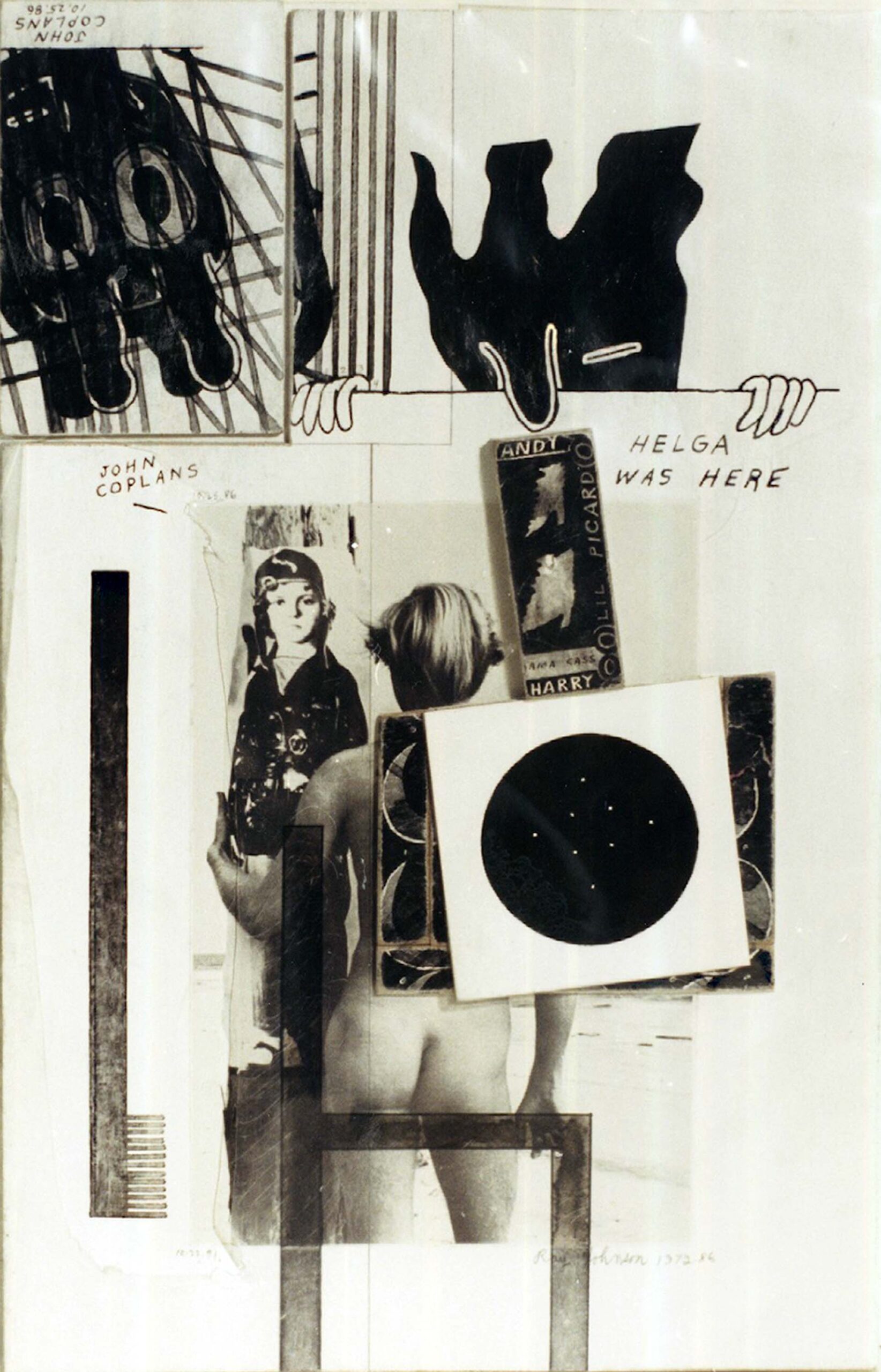
Ray Johnson
Untitled (Beach Bum with Shirley Temple)
1972-86 10.27.91
Collage on cardboard panel
14.25 x 8.875 in (36.2 x 22.5 cm)
Image courtesy of Jenny Gorman, © Ray Johnson Estate
Untitled (Beach Bum with Shirley Temple) (1974) features the image of Shirley Temple, the first child star of Hollywood and a natural interest for Johnson, who often featured media celebrities in his work. Temple frequently inhabited the role of a precocious Cupid, bringing together adult protagonists in her films. The figure of Cupid, especially its manifestation as a Valentine’s Day decoration, was an important motif Johnson used in numerous other works (see Untitled (Cupid with Marianne Moore’s Hatra).
The collage Untitled (Beach Bum with Shirley Temple) includes the bunny head, perhaps Johnson’s most widely used alter ego motif, and an image of Shirley Temple facing a photograph of a man’s bare buttocks, likely by taken by Johnson’s friend John Coplans, a curator, longtime editor of Artforum in the 1960s and 70s, and artist who almost exclusively photographed the human body. The idea of bodies flattened one on top of the other was a strong thematic in Johnson’s collages (see “Potato Mashers”).
The publicity photograph of Shirley Temple in an aviation suit was important to Johnson and was used in a number of other works. Unlike typical images of Temple in cute, puffy dresses, the child star here is depicted unsmiling and androgynously dressed as an aviatrix in trousers, a leather jacket and flight cap, and tap shoes.
Calling a cute boy Shirley Temple makes ridiculous the determined and repetitive process of cruising the dance floor for a suitable partner, even as associating the child performer with gay culture excites her overly sweet image. It distances Johnson from his own attraction. By calling the boy at the Anvil Shirley Temple, he both registers his attraction for the boy and belittles him by suggesting that he is only a mere copy of some kitschy original. At the same time the original star is brought down to earth; “she” can be seen anywhere. The boundary between the silver screen and everyday life is broken down.
– Jonathan Weinberg, “Ray Johnson Fan Club” in Donna De Salvo & Catherine Gudis, eds., Ray Johnson: Correspondences (Columbus: Wexner Center for the Arts, Ohio State University / Flammarion, 1999), p. 99.
By making a “man” out of a girl child star who was often sexualized for the straight male gaze, the image ties to Johnson’s other work exploring masculinization.
Ray Johnson (1927-1995) was born in Detroit, studied at Black Mountain College under Josef Albers, and moved to New York City in 1949 where he would live until 1962, at which time he moved to Glen Cove, Long Island. Over the course of his lifetime, Johnson pioneered a practice of mail art and collage works which were commercially difficult (small, arcane) and reflected the growing significance of mass media in 20th century life and the networked nature of the postwar art world. Integrating texts and images drawn from sources ranging from popular magazines to his personal telephone conversations, his work presents coded communication as a kind of self-portrait. Johnson occupies an idiosyncratic position in postwar American art between the assemblages and transfer drawings of Robert Rauschenberg and the work of Andy Warhol and other Pop artists.
His interest in language and semiotic systems looked to Dada and Marcel Duchamp while anticipating the development of appropriation strategies during the second half of the 20th century. Johnson sought out the random and the ephemeral, incorporating chance operations into his artistic practice with “mail art” and with performances and happenings. Operating under the intentionally misspelled mail art system he called the New York Correspondance [sic] School, Johnson used the art world as a network to distribute his collages and mail art pieces as well as to mine the mail he would receive for material for his collages, reifying the collaborations and ties to his contemporaries.
The Art Institute of Chicago holds the most extensive single collection and archive of works by Ray Johnson drawn from the recently acquired William S. Wilson Collection of Ray Johnson. The AIC presented a survey of Ray Johnson’s practice from November 26, 2021 through March 21, 2022.
Provenance
The Ray Johnson Estate
Other works by Ray Johnson
Ray Johnson, Marianne Moore Frank Sinatra, 1972-92
Ray Johnson, Untitled (Cupid with Marianne Moore’s Hatra), 1974
Ray Johnson, Untitled (Mona Lisa Graphic Print), n.d.
See also
A Lot of Shirley Temple Postcards Show, March 30 – April 25, 1968, Richard Feigen Gallery
Ray Johnson in the collection of the Art Institute of Chicago
Ray Johnson in the collection of the Metropolitan Museum of Art
Ray Johnson in the collection of the Whitney Museum of American Art
Art Institute of Chicago, “Ray Johnson c/o,” 26 November 2021 – 21 March 2022, with select full scans of the archives of the New York Correspondance [sic] School